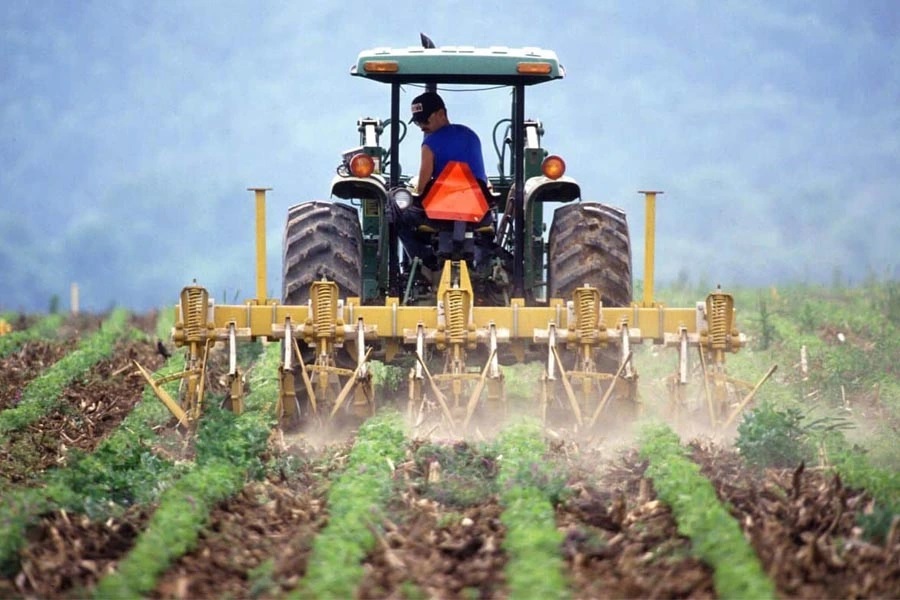Maximizing Efficiency With Tractor Mowing: The Go-To Guide For Landowners

Key Takeaways:
- Tractor mowing efficiency is determined by blade design, geometry, and materials.
- Utilizing high-lift blades enhances airflow and reduces fuel consumption.
- Mowing techniques should adjust based on terrain types to maintain safety and effectiveness.
- Choose the right tractor size and power based on land size and challenges for optimal results.
- Consider future land expansion needs when selecting a tractor to enhance long-term efficiency.
- Modern mower attachments, like mulchers and GPS systems, can significantly improve mowing efficiency.
- Timing your mowing according to grass growth cycles yields better results; early morning is ideal.
- Using varied mowing patterns promotes lawn health and aesthetic appeal, while reducing soil compaction.
- Adopting eco-friendly practices, such as energy-efficient equipment, can help reduce carbon footprints.
- Incorporating wildlife conservation into mowing strategies enhances biodiversity and supports local ecosystems.
Understanding the Science Behind Tractor Mowing Efficiency
The Physics of Cutting: How Blade Design Impacts Performance
Tractor mowing efficiency fundamentally relies on the science of cutting, which is influenced largely by the design and geometry of the mower blades. Blades are engineered from varied materials, often hardened steel, boasting sharp edges capable of making clean cuts. The angle of the blade’s edge plays a pivotal role; a sharper angle can create a finer, more precise cut, reducing the propulsion force required and consequently minimizing fuel consumption. Moreover, the design extends beyond simple sharp edges—high-lift blades, for instance, are designed with a unique curvature that generates airflow, lifting grass into the path of the cutting edge for an even cleaner process. These blades facilitate superior airflow and substance management, allowing for the effective dispersal of clippings, thereby promoting a healthier growth environment for the grass below.
Furthermore, the rotational speed of the blades and their width significantly influence mowing performance. Wider blades can cover more ground quickly, but they can also compromise the precision of the cut in uneven terrain. Hence, understanding the specific mowing conditions of your property, including grass types and growth patterns, allows for the optimization of blade selection, which is a critical component in achieving efficiency. It’s advisable to regularly inspect blades for wear and replace them when necessary to maintain optimal cutting performance.
Terrain Matters: Adjusting Techniques for Varying Landscapes
Mowing efficiency is undeniably affected by the terrain you are navigating. Different landscapes—be it hills, flatlands, or uneven grounds—demand varied mowing techniques for the best results. For instance, on sloped surfaces, utilizing a tractor with wider tires may help prevent slipping, while also maintaining cutting stability. Operating on a hill requires a slower speed and careful maneuvering to ensure that both the tractor and the mower maintain traction and avoid rollovers. It is often suggested to mow across the slope rather than straight up and down; this not only helps to avert risks but also reduces soil erosion and promotes healthier grass coverage.
When faced with uneven or rocky ground, adjusting the mowing height is crucial. A higher cutting setting may be advisable to prevent blade damage and ensure the mower maintains functionality. Moreover, navigating around obstacles like roots or stones means adopting a patient approach to mowing, requiring a keen eye and practiced technique. For significant landowners or those with mixed terrain, a versatile mower with adjustable height settings and multiple speed options will be essential. Understanding the unique challenges of your land will enable you to maximize the benefits of tractor mowing, yielding both efficiency and effectiveness.
Choosing the Right Tractor Mower for Your Property
Size and Power: Finding the Perfect Match for Your Land
In the world of tractor mowing, size and power are paramount. Having a tractor that is suited to the dimensions and nature of your land is essential in achieving efficient mowing. Large expanses of flat land might accommodate a bigger tractor with a wider mower deck, allowing for faster coverage and diminished mowing time. Conversely, smaller plots or properties with differential terrains may require compact tractors that boast agility and control. It’s crucial to assess both horsepower and operational capacity to ensure the selected mower can tackle the specific challenges of your landscape, whether it be thick, lush grass or more hardened terrain.
Moreover, the consideration of current and future needs is essential. While you might manage a small parcel of land now, growth and property enhancement plans may necessitate the purchase of a more powerful machine to accommodate lawn expansions. Thus, investing in a versatile tractor that can handle various attachments—such as brush hogs for tougher vegetation or finish mowers for manicured lawns—may prove beneficial. A well-suited tractor not only enhances mowing efficiency but is also a long-term investment that reduces operational stress and promotes sustainability.
Attachments and Features: Enhancing Your Mowing Experience
The array of attachments and features available with modern tractor mowers can significantly enhance your mowing experience, leading to improved efficiency and user satisfaction. Attachments such as mulchers and sweepers can convert clippings into organic matter, enriching the soil and reducing waste. Furthermore, advanced systems like GPS technology are revolutionizing tractor mowing by allowing for precise routing and documentation of mowing activity. This means you can track growth patterns and adjust your mowing schedules accordingly, optimizing the overall health of your landscape.
Additionally, the advent of automated mowing systems in conjunction with traditional tractors is changing the face of land management. These systems can intelligently detect growth rates and optimal mowing times, ensuring that you are getting the most out of your mower while also attending to the unique needs of your grass. Ergonomic features, such as adjustable seats and user-friendly controls, enhance operator comfort, enabling long hours of productive work without undue strain. Investing in modern attachments and features can transform mowing from a chore into an efficient and enjoyable task.
Mastering the Art of Mowing: Tips and Techniques for Optimal Results
Timing is Everything: When to Mow for Maximum Growth
In the world of land management, timing can dramatically alter the quality of mowing results. Understanding the growth cycle of your specific type of grass is essential for maximizing efficiency. Grass grows most vigorously during the early morning hours when temperatures are cooler and moisture content is higher—mowing during these times can yield a cleaner cut with less stress on the mower and plant. Additionally, adjusting your mowing schedule around seasonal changes is crucial. For example, during spring and fall when growth is rapid, regular mowing can stimulate healthy growth, while less frequent mowing during peak summer heat will protect the grass from stress.
Furthermore, incorporating a regimented mowing schedule allows for a consistent maintenance strategy that fosters a healthier lawn. Keeping clippings short enough to avoid matting, ideally not more than one-third of the grass height, enables better air circulation and sunlight exposure, leading to robust health. Planning for optimum conditions—considering weather forecasts and soil moisture levels—can drastically enhance the mowing process. Ultimately, mastering mowing timing is instrumental in ensuring professional-quality results and a thriving landscape.
Patterns and Strategies: Elevating Your Mowing Game
The technique behind the mowing pattern can drastically influence both the aesthetic and health of your grassy domains. Utilizing various mowing patterns—such as stripes, checkerboards, or spiral techniques—not only provides a visually appealing lawn but also encourages consistent growth across your property. Alternating between mowing patterns helps alleviate the stress placed upon the lawn, allowing for recovery and promoting a uniformly attractive appearance. By regularly changing up the mowing routes, you’re effectively reducing soil compaction and encouraging varied grass growth.
Moreover, employing strategic wide turns while mowing allows for a reduction in overlap, utilizing the mower’s width more efficiently and saving time. While aesthetic considerations are undeniably important, the underlying goal with every mowing session should focus on promoting healthy lawn habits. Implementing diverse patterns, careful overlapping, and timing strategies ensures that your mowing not only maintains an attractive appearance but also propels a vigorous, resilient landscape that is the envy of the neighborhood.
Sustainability and Tractor Mowing: Eco-Friendly Practices for Landowners
Reducing Your Carbon Footprint: The Role of Efficient Equipment
As awareness grows around ecological preservation, embracing sustainable practices in tractor mowing becomes ever more critical. One of the most effective methods to reduce your carbon footprint involves the selection of energy-efficient equipment. Modern tractors come equipped with fuel-efficient engines that significantly lower greenhouse gas emissions compared to older models. Investing in electric or hybrid mowers represents a substantial shift towards eco-friendliness, with many municipalities offering incentives for their adoption.
Moreover, maintaining equipment and tuning engines not only enhances performance but also fuels efficiency, conserving energy consumption. Regular oil changes, air filter replacements, and overall routine maintenance extend the lifespan of your machinery, reducing the need for frequent replacements and minimizing waste. Additionally, employing organic fertilizer methods post-mowing can foster a healthier ecosystem, supporting local flora and fauna while cutting down harmful runoff. By becoming a conscious and responsible landowner, you can optimize both your mowing efficiency and your commitment to environmental stewardship.
Integrating Wildlife Conservation: Mowing with Nature in Mind
Landowners can no longer ignore the importance of integrating wildlife conservation into their mowing practices. By embracing a wildlife-friendly approach, mowing can become an opportunity to enhance biodiversity rather than diminish it. For instance, conducting selective mowing—leaving certain areas of wildflowers or native grasses untouched—can create essential habitats for birds, insects, and other wildlife. These untouched patches not only provide visual appeal but are imperative for sustaining ecological balance; they serve as food sources for pollinators and play crucial roles in soil health. Establishing designated wildlife corridors through your mowing strategies encourages local species to flourish and contributes to the restoration of the surrounding ecosystem.
Furthermore, collaborating with local conservation organizations to understand the best practices for managing your land in an eco-friendly manner can result in long-term benefits for both landowners and wildlife alike. By understanding the interconnectedness of mowing, land management, and wildlife conservation, you can foster an environment that is sustainably managed, enriching not only your property but your local community as well.
FAQ
Question: How often should I mow my lawn for optimal health? – Regular mowing is recommended every 1-3 weeks, depending on grass growth and seasonal conditions. Mowing too infrequently can lead to overly tall grass, while mowing too often can stress the lawn.
Question: What is the best time of day to mow? – The ideal time to mow is early morning or late afternoon when temperatures are cooler and the grass is drier, reducing the risk of stressing your lawn and ensuring a clean cut.
Question: How can I determine the right mowing height for my grass type? – Different grasses have specific height requirements. As a general rule, maintaining a height of 2.5 to 3.5 inches promotes healthy growth; however, consult your grass type’s guidelines for precise recommendations.
Question: What type of mower is best for small versus large properties? – For small properties, a compact or push mower may be sufficient, while larger properties benefit from riding mowers or lawn tractors, which cover more ground quickly and efficiently.
Question: How can I reduce lawn mower noise pollution? – To minimize noise, consider using electric or battery-operated mowers, mow during less active hours, or invest in quieter mower models designed specifically for noise reduction.
Question: What should I do with grass clippings after mowing? – Grass clippings can either be bagged for disposal or left on the lawn as mulch, which returns nutrients to the soil and reduces the need for additional fertilizer.
Question: How can I maintain my mower to ensure it operates efficiently? – Regular maintenance includes sharpening the blades, changing oils, checking air filters, and cleaning the undercarriage to prevent buildup, all of which enhance performance and extend the mower’s lifespan.
Question: Are there any legal regulations on mowing in residential areas? – Yes, some local ordinances may enforce noise restrictions, mowing schedules, or lawn height regulations. It is advisable to check with your local authorities for specific guidelines in your area.
Useful Resources
- eXtension – Cooperative Extension Service
- University of Nebraska–Lincoln – Turfgrass Science
- Clemson Cooperative Extension
- Purdue University – Horticulture and Landscape Architecture
- Natural Resources Conservation Service
- Ohio State University – Agriculture and Natural Resources
- Federation University Australia – Land and Environment
- Nature – Scientific research and publications





